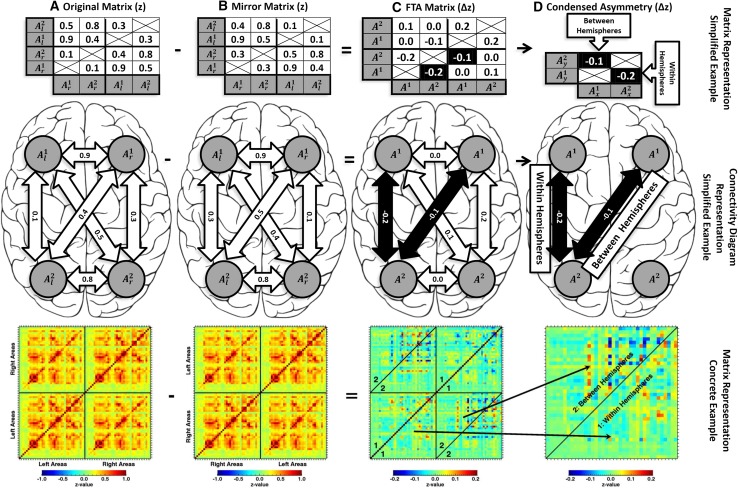Fig. 2.
Depiction of the used approach using a simplified and a more concrete example. The simplified example involves connections between four hypothetical areas and is depicted in the first two rows, once in matrix representation (row one) and once as a brain connectivity diagram (row two). The simplified example includes left hemisphere areas 1 and 2 and their contralateral homologues . The concrete example is depicted in matrix representation only (row 3), and includes all the connections between all left and right brain ROIs as represented in Fig. 1. The matrices containing the z-transformed RS correlations between the areas is established, with the rows and columns first ordered by hemisphere, then by area (a). A mirror matrix is calculated by swapping left and right areas, representing the connectivity of the same brain mirrored across the longitudinal fissure (b). The mirror matrix is subtracted from the original RS matrix, resulting in the AFC in the RS connections. Thus, the larger the difference between the original and mirror matrix, the larger the values in the AFC matrix (c). Note that there is a substantial amount of superfluous data in this matrix. To condense the matrix for more compact visualization, two non-redundant portions are extracted. These portions are highlighted in black in the simplified example and subsequently represent asymmetry of within-hemisphere connections (; meaning connectivity between left A2 along the horizontal/x axis of the matrix, and left A1 along the vertical/y axis of the matrix, minus connectivity between right A2 along the x axis of the matrix, and right A1 along the y axis of the matrix), and asymmetry of between-hemisphere connections (; meaning connectivity between right along the x axis of the matrix, and left A2 along the y axis of the matrix, minus connectivity between left A1 along the x axis of the matrix, and right A2 along the y axis of the matrix). The concrete example shows how these asymmetries of within- and between-hemisphere connections are represented by two triangular portions of the asymmetry matrix, which are combined to form the square condensed asymmetry matrix (d)

